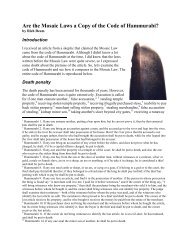Coming to Grips with the Early Church Fathers - Evidence for God ...
Coming to Grips with the Early Church Fathers - Evidence for God ...
Coming to Grips with the Early Church Fathers - Evidence for God ...
Create successful ePaper yourself
Turn your PDF publications into a flip-book with our unique Google optimized e-Paper software.
<strong>Coming</strong> <strong>to</strong> <strong>Grips</strong> <strong>with</strong> <strong>the</strong> <strong>Early</strong> <strong>Church</strong> Fa<strong>the</strong>rs’ Perspective on Genesis John Millam<br />
prefiguring <strong>the</strong> cross of Christ. 26 This is done by first interpreting 318 as 300+10+8. Next, <strong>the</strong><br />
numbers 10 and 8 are seen as denoting <strong>the</strong> letters “I” and “H” (<strong>the</strong> initials <strong>for</strong> Jesus) and 300 is<br />
denoted by “T,” which resembles a cross. 27<br />
While we may be confused and surprised by <strong>the</strong>se examples of “spiritual” ra<strong>the</strong>r than literal<br />
interpretation, it did not come from a low view of Scripture. The church fa<strong>the</strong>rs held a high view<br />
of Scripture—seeing even <strong>the</strong> most minute details as pointing <strong>to</strong>ward Jesus Christ. We must<br />
understand that <strong>the</strong> plain his<strong>to</strong>rical/literal interpretation would have had little meaning <strong>to</strong> <strong>the</strong><br />
fa<strong>the</strong>rs and <strong>the</strong>ir non-Jewish audience. By using non-literal association, <strong>the</strong>y could connect it <strong>to</strong><br />
<strong>the</strong>ir own lives.<br />
So <strong>the</strong> “literalists” shared <strong>the</strong> same need <strong>for</strong> a meaning beyond <strong>the</strong> simple literal as <strong>the</strong><br />
allegorists, whom I described last week, did. Most importantly, <strong>the</strong> literalists often employed<br />
nonliteral devices. In fact, <strong>the</strong> distinction between <strong>the</strong> literalists and allegorists is, at times, more<br />
an issue of degree than kind. Mook’s crisp delineation between <strong>the</strong> two groups is, <strong>the</strong>re<strong>for</strong>e,<br />
ra<strong>the</strong>r misleading. In sum, simply because <strong>the</strong> literalists did not resort <strong>to</strong> allegorical<br />
interpretation, it does not necessarily follow that <strong>the</strong>y always interpreted Scripture literally.<br />
Vic<strong>to</strong>rinus’ Numerology<br />
Vic<strong>to</strong>rinus of Pettau (late third century) is cited by Mook (and many o<strong>the</strong>rs) as teaching that <strong>the</strong><br />
creation days were specifically 24-hours long. This is based on <strong>the</strong> surviving fragment of his<br />
treatise, On <strong>the</strong> Creation of <strong>the</strong> World. Mook supports his conclusion <strong>with</strong> a short quote from<br />
Vic<strong>to</strong>rinus’ work, which I will include verbatim <strong>to</strong> show what details Mook does and does not<br />
include. 28<br />
Even such is <strong>the</strong> rapidity of that creation; as is contained in <strong>the</strong> book of Moses, which he<br />
wrote about its creation, and which is called Genesis. <strong>God</strong> produced that entire mass <strong>for</strong><br />
<strong>the</strong> adornment of His majesty in six days; on <strong>the</strong> seventh <strong>to</strong> which He consecrated it…In<br />
<strong>the</strong> beginning <strong>God</strong> made <strong>the</strong> light, and divided it in <strong>the</strong> exact measure of twelve hours by<br />
day and by night…<br />
This passage seems <strong>to</strong> be one of <strong>the</strong> strongest declarations in <strong>the</strong> early church that <strong>the</strong> days of<br />
creation were 24-hour periods—but a full reading paints a different picture. Vic<strong>to</strong>rinus’ primary<br />
focus is numerical association—not an attempt <strong>to</strong> correctly interpret Genesis 1. For example, <strong>the</strong><br />
fourth creation day he associates <strong>with</strong> <strong>the</strong> four elements, four seasons, four Gospels, four rivers<br />
in Eden (Genesis 2:10-14), four living creatures around <strong>God</strong>’s throne (Revelation 4:6–9), etc. He<br />
makes frequent use of <strong>the</strong> number seven (<strong>the</strong> key number in Genesis 1), relating it <strong>to</strong> at least<br />
twenty o<strong>the</strong>r occurrences throughout Scripture. Twenty-four also held great significance <strong>for</strong> him<br />
as found in <strong>the</strong> final paragraph of On <strong>the</strong> Creation of <strong>the</strong> World (which Mook does not quote).<br />
The day, as I have above related, is divided in<strong>to</strong> two parts by <strong>the</strong> number twelve—by <strong>the</strong><br />
twelve hours of day and night…There<strong>for</strong>e, doubtless, <strong>the</strong>re are appointed also twelve<br />
angels of <strong>the</strong> day and twelve angels of <strong>the</strong> night, in accordance, <strong>to</strong> wit, <strong>with</strong> <strong>the</strong> number<br />
26. The Epistle of Barnabas was popular in <strong>the</strong> early church, in part because its author was misidentified as being<br />
<strong>the</strong> biblical Barnabas.<br />
27. Bradshaw, Creationism and <strong>the</strong> <strong>Early</strong> <strong>Church</strong>, chapter 1.<br />
28. James Mook, “The <strong>Church</strong> Fa<strong>the</strong>rs on Genesis, <strong>the</strong> Flood, and <strong>the</strong> Age of <strong>the</strong> Earth,” 29–30.<br />
Page 9 <strong>Evidence</strong> <strong>for</strong> <strong>God</strong> from Science






